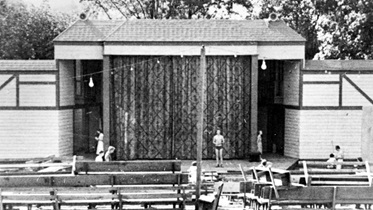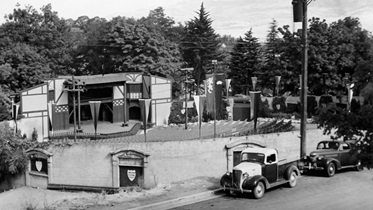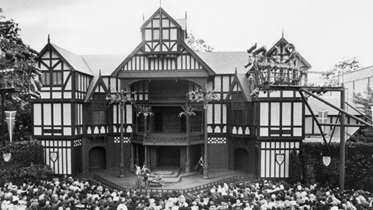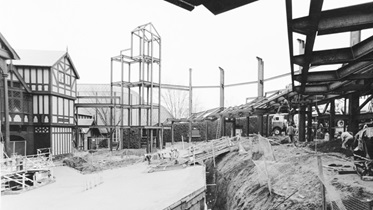
The Oregon
Shakespeare Festival has had three Elizabethan theatres, all of them located on the site of the old Chautauqua domes
(of which there were also three). The 1935 theatre was built in association with the City of Ashland’s Fourth
of July celebration, so the City was able to use a state-supported crew (funded through the WPA) to build a stage
and an Elizabethan façade. Angus Bowmer sketched a rough plan for the construction manager, using the
Elizabethan stage design by John Ashby Conway that he had helped to build for B. Iden Payne at the University of
Washington.
In 1940, a fire destroyed most of the stage, and in 1947 when the Ashland Chamber of Commerce asked Angus to restart
the Festival after WWII, the theatre was rebuilt and enlarged. This stage was built from plans also drawn by John
Ashby Conway. The dimensions of the theatre were mentioned in the contract for the construction of the 1599 Fortune
Theatre. This provided a larger forestage and side stages, as well as backstage areas that had not previously
existed.

Despite these
improvements and additional changes, by the 1958 season the Fire Marshal deemed the 1947 Elizabethan Stage a fire
hazard and prohibited further performances. The old structure was demolished on September 1, 1958, immediately at
end of the season. A fund-raising drive for a quarter of a million dollars for a new Elizabethan Stage began under
the leadership of longtime Festival supporters and members Alfred and Helene Carpenter.

The first step after
completely tearing down the 1947 stage was to remove the old Chautauqua wall that had encircled the stage. Richard
L. Hay’s design for the 1959 stage incorporated all the stage dimensions of the aforementioned Fortune Theatre
contract, as well as making wise use of his many years of experience as a designer and staff member of OSF. The wall
had to be removed because Hay’s plan required a semi-octagonal footing, not a circular one. Working with
Richard L. Hay on the project were architect Jack A. Edson, based in Medford, and building contractor Frank
Fairweather, also in business in the Rogue Valley.
Construction of the theatre took 11 months, continuing throughout the fall and winter of 1958 as the theater had to
be ready by July 1959. The paint was still wet when audiences filed in on July 28, 1959. Angus Bowmer wrote a public
letter of appreciation to those who helped build the theater and gave of their time, money and energy. “We
thank you all,” he wrote, “who built this monument…and generations of players and audiences yet
unborn will be grateful that you were the builders.”
The new theatre retained and enhanced the “unusual atmosphere of the existing bowl,” according to Angus.
The number of seats (1,143) remained the same; a raised terrace behind the seating was used by musicians and dancers
and underneath were housed the lighting and sound booths; and the rear of the bowl provided the same amount of space
for gift booths and landscaping. During the next decade some changes in seating were made so that by 1970 the
Elizabethan Stage could accommodate 1,173 audience members.
By the late 1980s it became clear that audiences in the Elizabethan Stage were having more difficulty hearing the
actors because of ever-rising ambient noise. Concerns were also expressed about the declamatory style of acting that
began to emerge as a counter to the noise filtering into the theatre. In 1989, festival leaders resolved to build an
enclosure for the Elizabethan Stage that would contain the actors’ voices within the theatre and keep street
noises outside. In addition, it was decided to incorporate other changes—to extend the stage, add vomitoria,
improve sightlines and expand the lighting.

Designed by Ian Macleod of
Treffinger, Walz & MacLeod in consultation with Richard L. Hay and S. Leonard Auerbach and Associates, ground
was broken on September 30, 1991. Within minutes of the ceremony, a grapple smashed a portion of the Chautauqua wall
(later rebuilt) and for eight months a well-directed construction schedule was followed.
With the addition of the balcony, the seating configuration changed, and the seating capacity changed only
slightly with the addition of 25 house seats, bringing the total of seats to 1,198. The new structure was
complete for the opening of the 1992 summer season. The Allen Pavilion was named in honor of The Allen
Foundation for the Arts, the largest contributor to the project.
In 2013 the Paul G. Allen Family Foundation awarded the Festival a $3,000,000 grant which supported the renaming
of the Elizabethan Stage/Allen Pavilion to the Allen Elizabethan Theatre and is also designed to support a broad
array of priority areas for OSF, such as funding the work on the stage, maintaining and restoring the
organization’s buildings, attracting visitors to experience live theater, in addition to other needs of
the organization.
Facts about the Allen Elizabethan Theatre:
- During the 1991 remodel the shape and height of balcony canopy was determined by an idealized lighting
position imagined by resident lighting designers. Similarly, side towers were formulated by ideal positions
for side light.
- Stage Lighting: control console is an ETC Obsession 1/600: there are 385 conventional fixtures; 20 color
mixers, 32 color scrollers, 5 Moving Lights, and 571 stage lighting circuits.
- Stage house is 45 ft. 8 inches from show deck to top of penthouse. Flag pole extends 10 ft. 7 inches above
that.
- There are four major acting levels, main stage, the outer above of 275 square ft., 11 ft. above mainstage
deck, the inner above and casement windows, 12 ft. 9 inches above stage deck, and musicians gallery, 23 ft 9
inches above deck. In addition, below the stage deck is a moat surrounding stage, 2 ft. 4 inches below stage
deck.
- Main stage acting area is diamond shaped with a truncated DS tip, useful acting space 43 ft. 5 inches left
to right upstage tapering to 19 ft. 4 inches Downstage. Stage depth at that point is 21 ft. 10 inches. There
are also two triangular stage areas to offstage of main acting area, each approximately 78 square ft.
- Stage deck is trapped in two areas, both on center line of building, both to a depth of 10 ft. DS is a 8 ft
x 8 ft. trap, and farther upstage is a trap 6 ft. wide extending 32 ft. upstage, under the slip stage.
- There is an 8 ft wide computer controlled motorized slip stage extending out of the stage house a maximum of
22 ft downstage. On top of that is a second track for a variable sized slip stage which may travel
independently anywhere along the slip stage.
- Limited rigging positions are possible off the center grid iron of the building above and downstage of
musicians gallery.
- Distance from front of stage to back of orchestra level is approximately 76 ft.
- Distance diagonally form front of stage to back seat in balcony is approximately 81 ft.